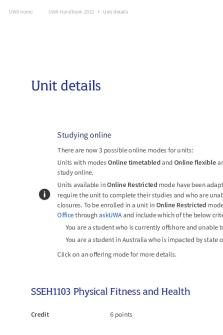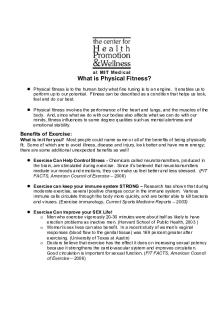HED Chapter 2 Principles of Physical Fitness PDF

| Title | HED Chapter 2 Principles of Physical Fitness |
|---|---|
| Course | Fundamentals of Nutrition and Fitness |
| Institution | Ventura College |
| Pages | 3 |
| File Size | 69 KB |
| File Type | |
| Total Downloads | 113 |
| Total Views | 142 |
Summary
HED V03 - Professor Maureen Eliot...
Description
CHAPTER 2: Principles of Physical Fitness Using the PowerPoint and lecture for Chapter 2, please explain the following: 1. Physical Activity and Exercise for Health and Fitness a. Definitions: i. Physical Activity: body movement carried out by skeletal muscles tat requires energy ii. Exercise: planned, structured, repetitive movement intended to improve or maintain physical fitness iii. Physical activity is essential to health, but exercise is necessary to improve fitness b. How Much? i. Increasing physical activity to improve health and wellness ii. Healthy adults should perform 150 minutes of moderate-intensity aerobic exercise or at least 75 minutes or vigorous-intensity exercise per week iii. Increasing the volume and intensity of exercise results in additional health benefits 2. Health-Related Components of Physical Fitness: Please write out the full component and briefly describe: a. CRE: i. Cardiorespiratory endurance: ability of body to perform prolonged, large muscle, dynamic exercise at moderate-to-high intensity ii. Central component of health-related fitness b. MS: i. Muscular strength: force a muscle produces with single maximum effort ii. Metabolism: sum of vital processes by which food energy and nutrients are made available to and used by the body 1. Greater muscle mass means a higher rate of metabolism c. ME: i. Muscular endurance: ability of muscle to remain contracted or to contract repeatedly for a long period of time d. FLEX: i. Flexibility: ability to move joints through their full ranges of motions e. BC: i. Body composition: proportion of fat and fat-free mass (muscle, bone, and water) in a body 1. Somatotype: body-type classification system that describes people as predominantly muscular (mesomorph), tall and thin (ectomorph), or round and heavy (endomorph) 3. List the Skill-Related components of Fitness: a. Complex control of muscles and movement by brain and spinal column b. Components include speed, power, agility, balance, coordination, and reaction and movement time 4. Principles of Physical Training / Adaption to Stress: Briefly describe each principle.
a. Specificity: training principle that states that to develop a particular fitness component, one must perform exercises designed specifically for that component i. A well-rounded exercise program should include exercises gered to each component of fitness b. Progressive Overload: training principle that states that placing increasing amounts of stress on the body causes adaptations that improve fitness i. As the amount of exercise progressively increases, fitness improves ii. FITT: 1. Frequency 2. Intensity 3. Time (duration) 4. Types (mode of activity) c. Reversibility: the training principle that states that fitness improvements are lost when demands on the body are lowereed i. If a person stops exercising, 50% of fitness improvements are lost within two months d. Individual Differences: there are large differences in our ability to improve fitness and perform skills i. Specific genes influence body fat, strength, and ensurance 5. Designing Your Own Exercise Program: a. Get Medical Clearance i. Risk from death in exercise is small ii. Physicaians may recommend an exercise strength test or a graded exercise test (GXT) to determine if a person might hav heart problems when exercising b. Assessment i. Assess your current level of fitness for each of the five fitness componenets c. Setting Goals i. Think carefully about you overall goals, and be clear about why you are starting a program d. Choosing Activities for a Balanced Program i. Combine active lifestyle with systematic exercise prgram ii. Cardiorespiratory endurance: continuous rhythmic movements of large-muscle groups 1. Bike or swim in ocean iii. Muscular strength and endurance: resistance training or calistehnics 1. Body weight exercises iv. Flexibility: stretching minor muscle groups regularly 1. yoga v. Healthy body composition: sensible diet and regular exercise vi. Physical Activity Pyramid 1. Sedendtray activities: read 2. Strength training: power yoga
3. Cardiorespiratory: bike, swim, surf, hike 4. Moderate-intensity physical activity: walk, bike, garden e. Guidelines for Training: Please choose 5 of the 16 that pertain to you, and highlight the one that MOST resonates with you, and write why it does. i. Train the way you want your body to train ii. Start slowly, and get in shape gradually iii. Exercise safely iv. Listen to your body and get adequate rest v. Train with a partner 1. I find that I don’t train well unless I am motivated by someone else. I like having another person so we can hold each other accountable during training....
Similar Free PDFs

Physical Fitness Chapter 1
- 6 Pages

Physical Fitness
- 4 Pages

Physical Fitness Quiz 1
- 2 Pages

Physical Fitness TEST PRE
- 14 Pages

Physical Fitness Finals
- 83 Pages

Physical Fitness TEST Score CARD
- 1 Pages
Popular Institutions
- Tinajero National High School - Annex
- Politeknik Caltex Riau
- Yokohama City University
- SGT University
- University of Al-Qadisiyah
- Divine Word College of Vigan
- Techniek College Rotterdam
- Universidade de Santiago
- Universiti Teknologi MARA Cawangan Johor Kampus Pasir Gudang
- Poltekkes Kemenkes Yogyakarta
- Baguio City National High School
- Colegio san marcos
- preparatoria uno
- Centro de Bachillerato Tecnológico Industrial y de Servicios No. 107
- Dalian Maritime University
- Quang Trung Secondary School
- Colegio Tecnológico en Informática
- Corporación Regional de Educación Superior
- Grupo CEDVA
- Dar Al Uloom University
- Centro de Estudios Preuniversitarios de la Universidad Nacional de Ingeniería
- 上智大学
- Aakash International School, Nuna Majara
- San Felipe Neri Catholic School
- Kang Chiao International School - New Taipei City
- Misamis Occidental National High School
- Institución Educativa Escuela Normal Juan Ladrilleros
- Kolehiyo ng Pantukan
- Batanes State College
- Instituto Continental
- Sekolah Menengah Kejuruan Kesehatan Kaltara (Tarakan)
- Colegio de La Inmaculada Concepcion - Cebu









